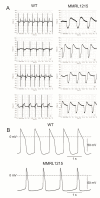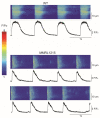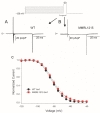Overlap Arrhythmia Syndromes Resulting from Multiple Genetic Variations Studied in Human Induced Pluripotent Stem Cell-Derived Cardiomyocytes
- PMID: 34281161
- PMCID: PMC8268422
- DOI: 10.3390/ijms22137108
Overlap Arrhythmia Syndromes Resulting from Multiple Genetic Variations Studied in Human Induced Pluripotent Stem Cell-Derived Cardiomyocytes
Abstract
Human induced pluripotent stem cell-derived cardiomyocytes (hiPSC-CMs) are used for genetic models of cardiac diseases. We report an arrhythmia syndrome consisting of Early Repolarization Syndrome (ERS) and Short QT Syndrome (SQTS). The index patient (MMRL1215) developed arrhythmia-mediated syncope after electrocution and was found to carry six mutations. Functional alterations resulting from these mutations were examined in patient-derived hiPSC-CMs. Electrophysiological recordings were made in hiPSC-CMs from MMRL1215 and healthy controls. ECG analysis of the index patient showed slurring of the QRS complex and QTc = 326 ms. Action potential (AP) recordings from MMRL1215 myocytes showed slower spontaneous activity and AP duration was shorter. Field potential recordings from MMRL1215 hiPSC-CMs lack a "pseudo" QRS complex suggesting reduced inward current(s). Voltage clamp analysis of ICa showed no difference in the magnitude of current. Measurements of INa reveal a 60% reduction in INa density in MMRL1215 hiPSC-CMs. Steady inactivation and recovery of INa was unaffected. mRNA analysis revealed ANK2 and SCN5A are significantly reduced in hiPSC-CM derived from MMRL1215, consistent with electrophysiological recordings. The polygenic cause of ERS/SQTS phenotype is likely due to a loss of INa due to a mutation in PKP2 coupled with and a gain of function in IK,ATP due to a mutation in ABCC9.
Keywords: action potentials; depolarization; electrophysiology; sodium current; stem cells.
Conflict of interest statement
The authors report no relationships that can be construed as a conflict of interest.
Figures








Similar articles
-
Biophysical comparison of sodium currents in native cardiac myocytes and human induced pluripotent stem cell-derived cardiomyocytes.J Pharmacol Toxicol Methods. 2018 Mar-Apr;90:19-30. doi: 10.1016/j.vascn.2017.11.001. Epub 2017 Nov 8. J Pharmacol Toxicol Methods. 2018. PMID: 29128504
-
Switch From Fetal to Adult SCN5A Isoform in Human Induced Pluripotent Stem Cell-Derived Cardiomyocytes Unmasks the Cellular Phenotype of a Conduction Disease-Causing Mutation.J Am Heart Assoc. 2017 Jul 24;6(7):e005135. doi: 10.1161/JAHA.116.005135. J Am Heart Assoc. 2017. PMID: 28739862 Free PMC article.
-
Electrophysiological mechanisms of vandetanib-induced cardiotoxicity: Comparison of action potentials in rabbit Purkinje fibers and pluripotent stem cell-derived cardiomyocytes.PLoS One. 2018 Apr 9;13(4):e0195577. doi: 10.1371/journal.pone.0195577. eCollection 2018. PLoS One. 2018. PMID: 29630634 Free PMC article.
-
Dysfunctional Nav1.5 channels due to SCN5A mutations.Exp Biol Med (Maywood). 2018 Jun;243(10):852-863. doi: 10.1177/1535370218777972. Epub 2018 May 27. Exp Biol Med (Maywood). 2018. PMID: 29806494 Free PMC article. Review.
-
Human Induced Pluripotent Stem Cell-Derived Cardiomyocytes as Models for Cardiac Channelopathies: A Primer for Non-Electrophysiologists.Circ Res. 2018 Jul 6;123(2):224-243. doi: 10.1161/CIRCRESAHA.118.311209. Circ Res. 2018. PMID: 29976690 Free PMC article. Review.
Cited by
-
Primary Electrical Heart Disease-Principles of Pathophysiology and Genetics.Int J Mol Sci. 2024 Feb 2;25(3):1826. doi: 10.3390/ijms25031826. Int J Mol Sci. 2024. PMID: 38339103 Free PMC article. Review.
-
Identification and characterization of two novel KCNH2 mutations contributing to long QT syndrome.PLoS One. 2024 Jan 5;19(1):e0287206. doi: 10.1371/journal.pone.0287206. eCollection 2024. PLoS One. 2024. PMID: 38181028 Free PMC article.
-
Pro-arrhythmic effects of gain-of-function potassium channel mutations in the short QT syndrome.Philos Trans R Soc Lond B Biol Sci. 2023 Jun 19;378(1879):20220165. doi: 10.1098/rstb.2022.0165. Epub 2023 May 1. Philos Trans R Soc Lond B Biol Sci. 2023. PMID: 37122211 Free PMC article. Review.
-
Interpreting the actionable clinical role of rare variants associated with short QT syndrome.Hum Genet. 2024 Dec;143(12):1499-1508. doi: 10.1007/s00439-024-02713-x. Epub 2024 Nov 6. Hum Genet. 2024. PMID: 39503779 Free PMC article.
References
-
- Terrenoire C., Wang K., Tung K.W.C., Chung W.K., Pass R.H., Lu J.T., Jean J.-C., Omari A., Sampson K.J., Kotton D., et al. Induced pluripotent stem cells used to reveal drug actions in a long QT syndrome family with complex genetics. J. Gen. Physiol. 2012;141:61–72. doi: 10.1085/jgp.201210899. - DOI - PMC - PubMed
MeSH terms
Substances
Supplementary concepts
Grants and funding
LinkOut - more resources
Full Text Sources
Medical
Miscellaneous

